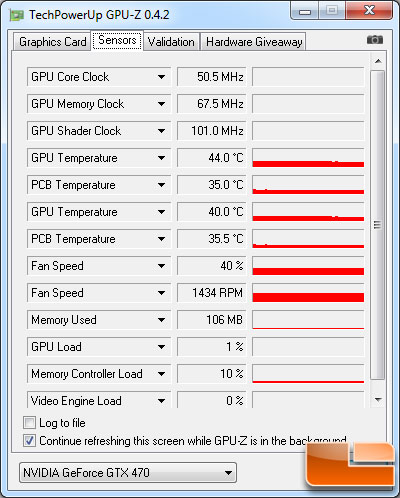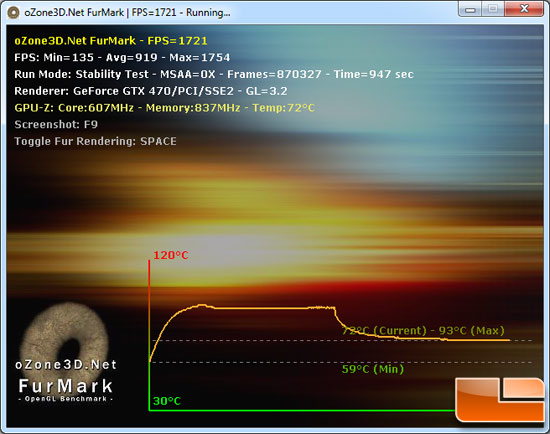ASUS GeForce GTX 470 ENGTX470 Video Card Review
Temperature Testing
Since video card temperatures and the heat generated by
next-generation cards have become an area of concern among enthusiasts
and gamers, we want to take a closer look at how the ASUS GeForce GTX 470 graphics card does
at idle and under a full load.
NVIDIA GeForce GTX 470 Video Card Idle Temperature:

At idle on an open test bench the GeForce GTX 470 had some pretty good temperature numbers, which makes sense as we pointed out on the previous page the card has solid idle power consumption numbers. We were seeing right around 44C at idle, which isn’t as bad as we expected to be honest. As you can see from the screen shot above, the idle state
of the GeForce GTX 470 drops the GPU core clock frequency down to just 50MHz and the
memory clock down to 67.5MHz to help conserve power and lower
temperatures. The fan spins at 1434RPM at 40% rotation speed when at idle.
NVIDIA GeForce GTX 470 Video Card Load Temperature:

We fired up FurMark and ran the stability at 640×480, which was
enough to put the GPU at 100% load in order to get the highest load
temperature possible. This application also charts the temperature
results so you can see how the temperature rises and levels off, which
is very nice. The GeForce GTX 470 maxed out at 93C. The fan on the GeForce GTX 470 video card was left on auto during temperature testing and the fan speed is
dynamic. This means that it will increase/decrease depending on the GPU
temp and GPU load. You can see a slight dip in temperatures at the start of the test as the GPU fan was still spinning up to a higher speed to keep up with all the heat. The card peaked at 93C then the fan speed increase was able to cool the card down and keep the temperature level at around 86C. When we hit the space bar to stop the rendering the temperature dropped. Since a 2D application was open the card wouldn’t go back to a complete idle state, but as you can see the temperature dropped and started to level off around 73C.
| GTX 480 1 LCD | GTX 480 2 LCD | GTX 470 1 LCD | GTX 470 2 LCD | |
| vBios | 70.00.19.00.02 | 70.00.19.00.02 | 70.00.1A.00.03 | 70.00.1A.00.03 |
| Core Clock | 50.0MHz | 405MHz | 50.0MHz | 405MHz |
| Mem Clock | 67.5MHz | 924MHz | 67.5MHz | 837MHz |
| Shader Clock | 101.0MHz | 810MHz | 101.1MHz | 810MHz |
| Idle Temp | 50C | 75C | 44C | 74C |
| Idle Power | 166W | 236W | 142W | 217W |
| Fan Speed | 1758RPM | 1985RPM | 1434RPM | 1602RPM |
In our GeForce GTX 480 launch article we discovered that multi-monitor setups on the GeForce GTX 400 series would cause the GPU temperature to sky rocket, but after a number of BIOS revisions the engineers over at NVIDIA finally got it right by changing the fan profiles. We tried testing the ASUS ENGTX470 with two LCD displays and found that both the GeForce GTX 470 and 480 graphics cards share similar performance numbers when it comes to running two displays off one video card. Notice that running two monitors caused the idle power consumption to jump up 75 Watts.

Comments are closed.